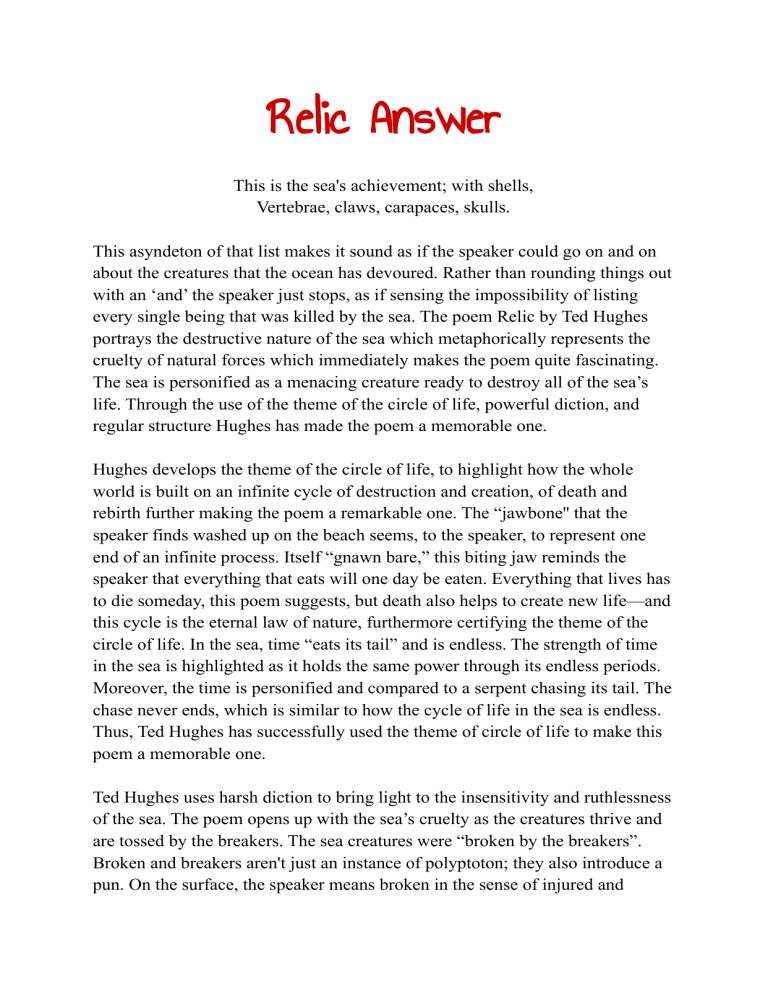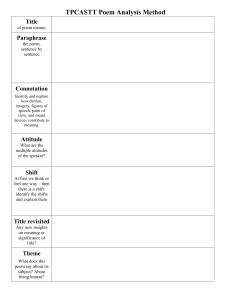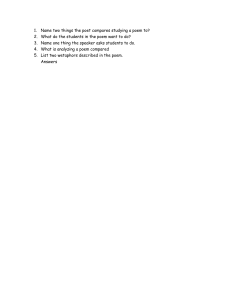
Relic Answer This is the sea's achievement; with shells, Vertebrae, claws, carapaces, skulls. This asyndeton of that list makes it sound as if the speaker could go on and on about the creatures that the ocean has devoured. Rather than rounding things out with an ‘and’ the speaker just stops, as if sensing the impossibility of listing every single being that was killed by the sea. The poem Relic by Ted Hughes portrays the destructive nature of the sea which metaphorically represents the cruelty of natural forces which immediately makes the poem quite fascinating. The sea is personified as a menacing creature ready to destroy all of the sea’s life. Through the use of the theme of the circle of life, powerful diction, and regular structure Hughes has made the poem a memorable one. Hughes develops the theme of the circle of life, to highlight how the whole world is built on an infinite cycle of destruction and creation, of death and rebirth further making the poem a remarkable one. The “jawbone'' that the speaker finds washed up on the beach seems, to the speaker, to represent one end of an infinite process. Itself “gnawn bare,” this biting jaw reminds the speaker that everything that eats will one day be eaten. Everything that lives has to die someday, this poem suggests, but death also helps to create new life—and this cycle is the eternal law of nature, furthermore certifying the theme of the circle of life. In the sea, time “eats its tail” and is endless. The strength of time in the sea is highlighted as it holds the same power through its endless periods. Moreover, the time is personified and compared to a serpent chasing its tail. The chase never ends, which is similar to how the cycle of life in the sea is endless. Thus, Ted Hughes has successfully used the theme of circle of life to make this poem a memorable one. Ted Hughes uses harsh diction to bring light to the insensitivity and ruthlessness of the sea. The poem opens up with the sea’s cruelty as the creatures thrive and are tossed by the breakers. The sea creatures were “broken by the breakers”. Broken and breakers aren't just an instance of polyptoton; they also introduce a pun. On the surface, the speaker means broken in the sense of injured and breakers in the sense of waves. The ocean itself, the poem suggests, smashes its own creatures to bits. This showcases the harsh diction which Hughes has used to demonstrate the barbarity of the sea. The jawbone, now, is nothing but a cenotaph. The fish whose jawbone this was, in other words, lived not for pleasure, but to devour—and its own stray bone is now a monument to the ceaseless brutality of nature. The word "cenotaph" suggests not just a monument, but a monument to the victims of war, whose bodies are scattered and unrecoverable. When the poem describes this jawbone as a "cenotaph," then, it suggests that the speaker is seeing it as a symbol. Thereby, adding to the brutish diction that Hughes chose. The speaker states “In that darkness camaraderie does not hold.” That rhyme invites readers to linger on this idea for a moment. Down in the dark of the sea, the speaker insists, there's no such thing as camaraderie, no friendship. There's only the law of the briny deep: you're either having lunch or becoming lunch! The speaker's choice of this rather light, elegant word introduces a note of dark humour here. Thus, by the use of these excruciating phrases Hughes has made the poem quite enthralling. Hughes's application of the structure shows the unpredictability of the sea, further showing how dangerous the sea is. The poem's three stanzas move from a cinquain (five-line stanza) to a sestet ( six-line stanza), then back to a cinquain again. This pattern of growth and shrinking mimics precisely what the poem describes: the endless cycle of birth and death, eating and being eaten, that is the fate of all animal life. This free verse poem doesn't use any steady metre. But its measured lines, all roughly the same length, give the speaker's voice a steady, meditative tone. The poem moves along at a walking pace, just like the speaker ambling down the beach and reflecting on nature's indifferent brutality. While there's no consistent rhyme scheme here, irregular flickers of rhyme mark some of this free verse poem's most pointed insights. The asyndeton list is a list of the lexical field of bones which suggests something infinite. By refusing to close this list with an "and," the poem suggests that it's only just begun to describe all the ruined fragments of dead animals lying strewn around on this beach. The list, the speaker's asyndeton implies, could go on; the speaker has only stopped because it's pointless even to try to enumerate every single bit of dead matter on the shore. The structure has significantly highlighted the capriciousness of the sea, further manifesting how dangerous the sea is. After a close analysis of the poem, it is evident that Hughes is successful in making the poem a memorable one through the use of harsh diction, the theme of the circle of life, and the structure. These techniques allow him to provide the readers with an insight into the ruthless nature of the sea.



